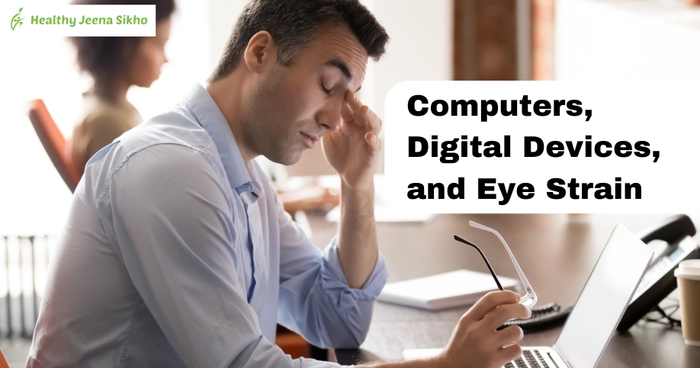|
In today's digital age, we spend an increasing amount of time in front of screens—whether it's working on a computer, scrolling through smartphones, or even enjoying virtual reality (VR). While these devices offer convenience and entertainment, they also come with a downside: digital eye strain, a condition that affects millions of people worldwide. In this blog, we’ll explore how extended use of computers and digital devices impacts our eyes, the risks associated with VR, and what you can do to protect your vision. What is Digital Eye Strain?Digital eye strain, also known as computer vision syndrome (CVS), refers to a group of eye-related problems caused by prolonged screen use. When you stare at a screen for long periods, your eyes need to work harder to focus, leading to discomfort and fatigue. Common symptoms of digital eye strain include: - Blurred vision - Dry or irritated eyes - Headaches - Neck and shoulder pain - Difficulty concentrating These symptoms occur because our eyes are not designed to focus on digital screens for extended durations, especially without breaks. The blue light emitted from digital devices, combined with reduced blinking, can exacerbate these issues, causing both short-term discomfort and potential long-term damage. How Digital Devices Affect Your Eyes1. Reduced BlinkingWhen using computers, smartphones, or tablets, people tend to blink less frequently. Normally, we blink about 15-20 times per minute, but this rate can drop by as much as half when focusing on a screen. Reduced blinking leads to dry eyes, as blinking is essential for spreading tears evenly across the eye's surface. 2. Blue Light ExposureDigital screens emit blue light, which can contribute to digital eye strain. While some blue light exposure is natural (it comes from the sun), the artificial blue light from screens can cause additional strain, especially during prolonged use. There’s growing concern that extended exposure to blue light may also contribute to age-related macular degeneration, though research is still ongoing. 3. Prolonged FocusFocusing on a digital screen for long periods requires constant effort from the muscles in your eyes, which can lead to strain. Over time, this can affect your ability to focus on objects both near and far, causing blurred vision. 4. Close Viewing DistanceWhether it’s a smartphone or a computer, digital devices are often held or placed close to the eyes, causing them to work harder. This increases the risk of eye fatigue and strain. VR and Its Impact on Eye HealthVirtual reality (VR) has gained popularity in gaming, education, and even healthcare. While VR offers an immersive experience, it also poses some risks to eye health. When using VR headsets, your eyes are subjected to close-up screens and unique visual effects that can affect your vision in several ways: 1. Eye FatigueVR requires users to focus intensely on images that are often very close to their eyes. This can cause significant eye strain, particularly when used for extended periods without breaks. 2. Convergence and Accommodation MismatchOne of the biggest concerns with VR is the "convergence and accommodation mismatch." In the real world, your eyes adjust their focus (accommodation) and angle (convergence) to view objects at different distances. In VR, your eyes converge on a point in the virtual space, but the lenses inside the headset project images onto a screen that’s very close to your eyes. This mismatch can cause visual discomfort and make it harder for your eyes to focus after you remove the headset. 3. Motion Sickness and DizzinessSome users experience motion sickness or dizziness after using VR, caused by a disconnect between the visual information presented by the headset and the body’s actual movements. This can also lead to eye strain, as the eyes attempt to adjust to the conflicting information. 4. Potential for Long-term ImpactWhile research on the long-term effects of VR on eye health is still in its early stages, there are concerns that frequent use may cause persistent visual discomfort or changes in vision. For children, whose eyes are still developing, prolonged VR use may pose additional risks, though more studies are needed to fully understand the long-term impact. Tips to Prevent Digital Eye StrainFortunately, there are several simple steps you can take to reduce digital eye strain and protect your vision, whether you're using a computer or VR headset. 1. Follow the 20-20-20 RuleEvery 20 minutes, take a 20-second break and look at something 20 feet away. This helps relax the eye muscles and reduces strain. 2. Adjust Your Screen SettingsLower the brightness of your screen and adjust the contrast to reduce glare. Many devices also offer a "night mode" that reduces blue light emissions. 3. Blink More OftenMake a conscious effort to blink more frequently when using digital devices. This will help keep your eyes moist and prevent dryness. 4. Use Blue Light FiltersBlue light-blocking glasses or screen protectors can help reduce exposure to harmful blue light. Some digital devices also come with built-in blue light filters, which can be activated in the settings. 5. Position Your Screen ProperlyEnsure that your computer screen is about an arm's length away from your eyes and that the top of the screen is at or just below eye level. This helps minimize strain caused by improper viewing angles. 6. Take Breaks from VRWhen using VR, take frequent breaks to rest your eyes. Limit your sessions to 20-30 minutes and avoid using VR right before bed to prevent eye fatigue. 7. Consult an Eye Care ProfessionalIf you experience persistent eye discomfort or strain, schedule a visit with an optometrist or ophthalmologist. They can recommend personalized strategies or eyewear to reduce strain and protect your eyes. ConclusionIn a world increasingly dominated by digital devices, it’s more important than ever to protect our eyes. While computers, smartphones, and VR headsets have revolutionized the way we live and work, they also contribute to digital eye strain and potential long-term vision problems. By adopting simple practices like following the 20-20-20 rule, adjusting your screen settings, and taking breaks from VR, you can reduce the impact of digital devices on your eye health. Don’t take your eyes for granted—make eye care a priority in your digital routine. |

